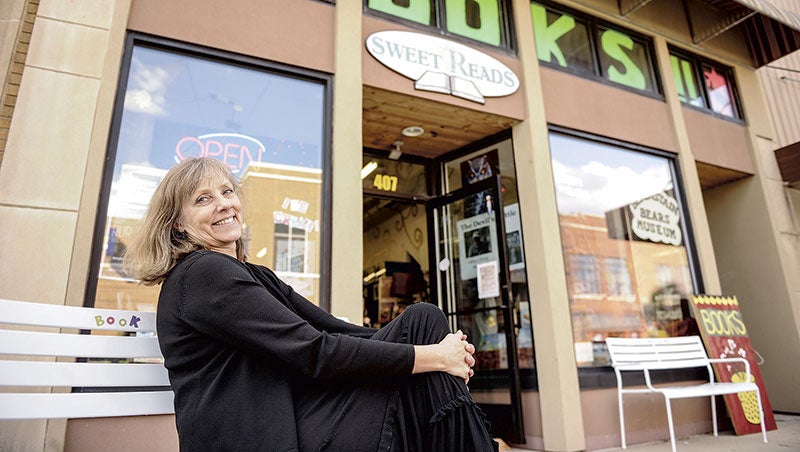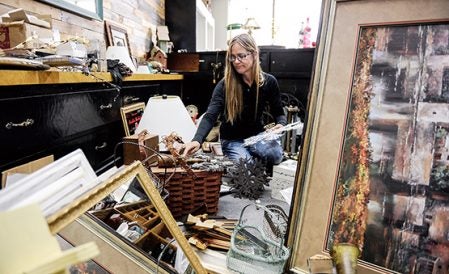Downtown Austin retailers agree city has challenges, but stores do succeed
Published 7:32 am Sunday, October 8, 2017

- Lisa Deyo and her Sweet Reads bookstore is one of the new businesses to find a home on Main Street. Her set-up across from the Spam Museum allows for the potential of many more shoppers. Eric Johnson/photodesk@austindailyherald.com
About this series: The Austin Daily Herald is examining the state of Austin’s retail sector and what can and is being done to improve it.
Read part one here: Austin struggles as shoppers opt to travel; City competes with neighbors in a 40-mile radius for customers, retailers
Read part two here: Nurture niches in Austin, regional retail expert says; Retail strategy development tools include tapping incubators in other cities
Read part three here: Good jobs will boost retail, city leaders say
If the University of Minnesota Extension Retail Analysis says that sales in Austin are under-performing, some Main Street business owners seem unimpressed by the news.
Making a go of retail business has never been easy, said Lou Beckel of Lou’s Forever Framing. She said she has seen a lot of businesses open and close over the 18 years she has been in the downtown.
Sure, internet shopping has had a definite impact on her business and a lot of others. And, retailers realize that Austin is not well-located for drawing people to its stores. Proximity to other shopping centers in Rochester, Owatonna and Albert Lea have combined to give Austin a less-than-admirable “pull” factor. Some shoppers interviewed for this article — who did not want to be identified — most often talked about a lack of clothing stores in the community, and the loss of Target. Another mentioned wanting another lumber supplier in town.
Despite those contentions, retailers downtown seem relatively upbeat about selling goods here — and if they are inconveniently located as a community, they say, you just have to give people a reason to come their way.
“I think we’re doing the right things,” said Marie Fryer, owner of the Belles and Beaus bridal shop, a business she has operated for over 20 years in Austin.
There are a lot of reasons a business succeeds which don’t necessarily have anything to do with location, retailers say. The major local retail centers — Sterling Main Street, the 18th Avenue Northwest corridor and the downtown — all have challenges.
A strong Chamber of Commerce, presentation, unique products, adaptability to change and just good, old-fashioned elbow grease all impact success, too.
Advice to new retailers: ‘Give it time’
Some retailers just don’t give their businesses time to catch on, said Beckel.
“Sometimes you just have to wait it out — but I’ve seen some people open and close in a year’s time. It’s just not long enough to catch on, sometimes. You have to give it a chance.”
The type of product being sold makes a difference. Customers may travel longer distances for certain items. It could be cars for one set of shoppers, or it could be a downtown filled with unique shops or attractions for another set.
Bridal gowns are another good example. Fryer, said she felt her business has drawn customers to Austin. Belles and Beaus “has had a loyal customer base,” that comes from a 50- to 75-mile radius around Austin, she said. It’s been that way for over 20 years.
It has been hard and fulfilling work. She has worked “eighty-hour weeks; I’d be here from 6:30 in the morning, into the evening; you had to be here on Saturdays.”
Businesses must adapt to what customers want
Both Beckel and Fryer said, however, that times change — and with it, the emphasis of the business changes.
For Beckel, that meant a move from framing a lot of prints for home decor, to a customer base that today prefers to frame “those things that really mean something to them,” she said, such as handwork, old photographs or family artwork.
That preference has translated to changes in the business as well. Today, more business comes in for custom framing than in pre-made frames.
“I remain very busy” even though the business emphasis has shifted, she said.
Over the years, she has augmented sales by stocking gift items — vintage trunks were a big hit for a time until her supplier no longer carried them — “because you have to keep trying different things,” she said. “Some things catch on, others don’t — but you just keep trying.”
Fryer’s business has been impacted by the internet. While some shoppers choose to buy online — “I mean, dresses are half-price, but so is the quality,” she said — she still remains busy. She has a full line of accessories, tuxedos and alterations. She hopes, she said, that another bridal shop comes to town when she retires in mid-December.
“I’ve loved every minute of it,” she said. And, she has enjoyed the camaraderie of the downtown business community. Still, the long hours and a desire to spend more time with family prompted her retirement decision.
Offering what the internet cannot
A newcomer to the downtown says her business has been sustained by community support, “a creative husband,” and location.
But others might tell you that her weekly offerings of author talks and children’s events have made their mark, too.
Lisa Deyo, owner of Sweet Reads, has a bookstore that sits directly across from the Spam Museum.
Her husband, John — another small business owner, who has ViDeyo Arts Video Production Studio two blocks south, also on Main Street — thought a bookstore “was a terrible idea,” given the overwhelming attraction of internet giants like Amazon.
But when a storefront opened up right across from the Spam Museum, those feelings changed.
“Now, you have a potential of 100,000 visitors a year, right across the street,” he said, and the bookstore was a go.
Still, he said, internet shopping has had a major impact on all business. But Lisa said what she offers is more than books, and knew she could not compete with the Amazons and Barnes and Nobles.
So, she did not try.
“My business is a discovery zone,” said Lisa. She has worked from the beginning in June 2016 “to create experiences” for customers — with “meet and greets” featuring local and Minnesota authors; kids’ nights in costumes, with the help of Matchbox Children’s Theatre, and other events. A Sherlock Holmes night — with customers solving a mystery — comes later this month.
The store is unique, with an interior styled into areas that draw children, such as a train replica, a science area, or a meeting area around a fireplace. She has special activities every week, although she also teaches elementary school full-time.
“We make connections here,” she said. “People love sitting in here, catching up.”
Connections, said John Deyo, is a key to a vibrant downtown.
“I’m not going to come downtown to buy a widget,” he said. “I’m coming to downtown to experience a local connection. I can go elsewhere to get a cup of coffee, but I go to Kyle’s (Kyle Keenan, of Coffee House on Main), because of the experience, and being able to sit and talk.”
Local businesses need local support
Not all experiences have been good ones.
Jill Jones, who operated Willow Cove home decor store, closed her shop in August.

Jill Jones, owner of Willow Cove on Main Street, packs up her merchandise in August after deciding to close her doors due to lack of business. Eric Johnson/photodesk@austindailyherald.com
Her business, on Main Street since 2014, was successful in some areas, but not overall. She wished that potential customers would have given her the opportunity to show them what she had.
“Why am I closing?” she said in August. “That’s the million dollar question. You hear people talking about what a community doesn’t have — but they don’t stop in your store. How do they expect stores to stay open? Some people are so quick to blame the city, but it’s not your city, it’s your community. You have to patronize your own businesses.”
Still, she said, she is excited about a new venture in her family. Her husband, Kevin, is part owner with his brother, Joe, of the soon-to-open Angry Hog Taproom and Brewery, that will be in the former Jimmy’s Fish and Seafood location.
Jones said she found Main Street supportive. The Austin Chamber of Commerce “was amazing” but still, advertising did not result in a larger customer base. She said she would still hear, ‘Oh, I didn’t know you were there,’” she said. She will, however, continue her milk paint sign workshops and the Black Willow Brewing supplies, which she carried in her shop, will be sold at the brewery location.
Nancy Schnable, head of Discover Austin, the community’s Convention and Visitor’s Bureau, said while retail is not her area of expertise, she knows “what attracts customers to a town is a complex thing.”
She also knows shopping the internet instead of patronizing local business has more impact than many understand. Shopping locally keeps dollars working in the community; sending them to another state when ordering online does nothing for the community at large.
“And our store owners are your active community members who are responsible for a lot of events going on in town; if they leave, we don’t only lose the products they sell, we also lose their energy and willingness to work for the community,” she said.
“Shopping on the internet is appropriate in some instances; however, you don’t get that sense of community. Your computer just doesn’t give you that same feeling. Going to a store connects you to a community; you learn things along the way. It’s human interaction — and why wouldn’t you want that?” she said.
Overall, “Not every town has everything.”
“Austin has a lot to offer and we’ll offer anything we can,” Schnable said. “We can grow, but we can also utilize what we have already.”





